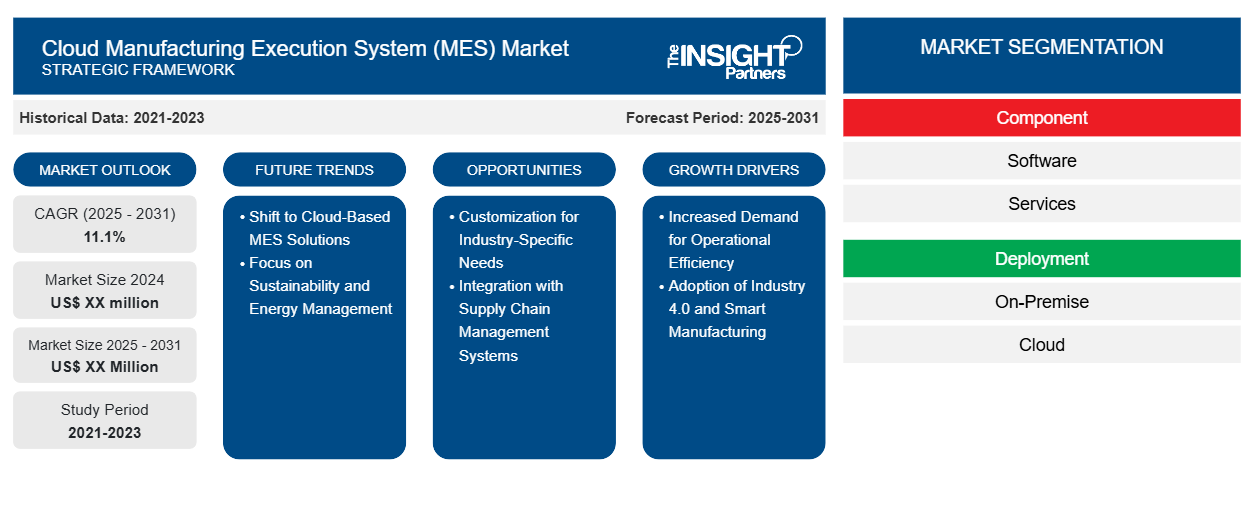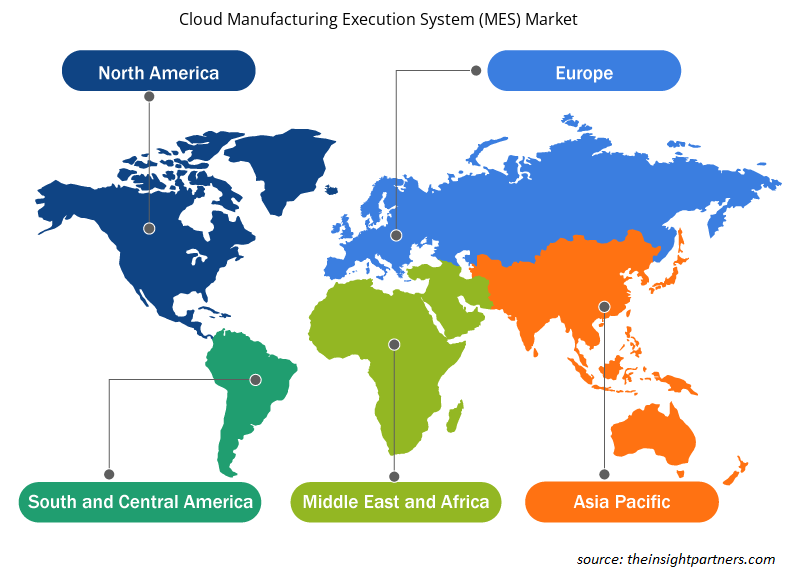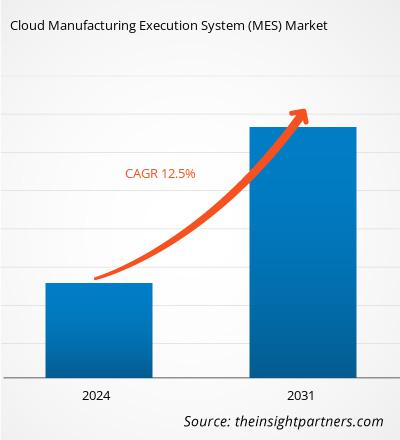Si prevede che il mercato dei Cloud Manufacturing Execution System (MES) raggiungerà i 24,13 miliardi di dollari entro il 2031, rispetto ai 10,64 miliardi di dollari del 2024. Si stima che il mercato registrerà un CAGR del 12,5% nel periodo 2025-2031. La crescente integrazione della tecnologia dei gemelli digitali porterà probabilmente nuove tendenze nel mercato nei prossimi anni.
Analisi di mercato del Cloud Manufacturing Execution System (MES)
La crescente domanda di soluzioni MES convenienti è uno dei principali fattori che guidano la crescita del mercato. Le soluzioni MES cloud sono spesso disponibili in abbonamento, consentendo ai produttori di ottenere le risorse di elaborazione e le licenze software necessarie senza investire nella propria infrastruttura IT. L'integrazione delle tecnologie MES cloud e Industria 4.0 sta trasformando il settore manifatturiero, consentendo connettività in tempo reale, analisi migliorate, manutenzione predittiva e maggiore automazione. Poiché i sistemi MES cloud offrono flessibilità di personalizzazione, si prevede che la loro domanda aumenterà nei prossimi anni. Inoltre, poiché le soluzioni MES cloud ibride aiutano a trasferire dati non critici al cloud, mentre le funzionalità critiche di esecuzione della produzione rimangono on-premise, in modo sicuro e protetto, si prevede che l'adozione di soluzioni MES cloud ibride aumenterà nel periodo previsto . Infine, si prevede che l'integrazione della tecnologia del gemello digitale con le soluzioni MES cloud introdurrà nuove tendenze sul mercato in futuro.
Panoramica del mercato del Cloud Manufacturing Execution System (MES)
Un sistema di esecuzione della produzione (MES) basato su cloud è una soluzione software all'avanguardia per la gestione e l'ottimizzazione delle operazioni di produzione utilizzando la tecnologia cloud. A differenza dei tradizionali sistemi on-premise, che si basano su server e infrastrutture localizzati, un MES basato su cloud utilizza server remoti per fornire dati in tempo reale e analisi avanzate da qualsiasi luogo con una connessione Internet. Questo sistema funge da hub per tutte le attività relative alla produzione, come la pianificazione, la gestione dell'inventario, il controllo qualità e il monitoraggio delle attrezzature. Il software MES basato su cloud è progettato per interagire facilmente con altre tecnologie aziendali, come i sistemi ERP , per fornire una piattaforma unificata per il monitoraggio e l'ottimizzazione di ogni fase del processo produttivo. Il principale vantaggio di un MES basato su cloud è la sua flessibilità e scalabilità. I produttori possono modificare le funzionalità del sistema per soddisfare gli obiettivi di produzione senza sostenere ingenti costi iniziali. I modelli di prezzo basati su abbonamento rendono questi sistemi più accessibili riducendo i costi finanziari e tecnici associati alle alternative on-premise. Questa combinazione di accessibilità, integrazione e scalabilità rende il MES basato su cloud uno strumento cruciale per le aziende che desiderano aggiornare i propri sistemi di produzione.
Personalizza questo report in base alle tue esigenze
Riceverai la personalizzazione gratuita di qualsiasi report, incluse parti di questo report, analisi a livello nazionale, pacchetto dati Excel e potrai usufruire di fantastiche offerte e sconti per start-up e università.
Mercato del Cloud Manufacturing Execution System (MES): approfondimenti strategici

- Scopri le principali tendenze di mercato di questo rapporto.Questo campione GRATUITO includerà analisi di dati che spaziano dalle tendenze di mercato alle stime e alle previsioni.
Driver e opportunità di mercato del Cloud Manufacturing Execution System (MES)
Integrazione con Industria 4.0
L'integrazione tra Industria 4.0 e cloud MES segna un cambiamento significativo nel settore manifatturiero. Industria 4.0 utilizza tecnologie all'avanguardia come l'Internet of Things ( IoT ), l'intelligenza artificiale (IA), l'analisi dei big data e l'automazione intelligente per creare ambienti di produzione intelligenti e interconnessi. Cloud MES funge da canale per lo scambio di dati in tempo reale tra i reparti di produzione e i sistemi aziendali di livello superiore. Questa competenza è fondamentale nel contesto di Industria 4.0, dove dati rapidi e affidabili sono necessari per il processo decisionale. Combinando cloud MES e dispositivi IoT , i produttori ottengono una prospettiva olistica del processo di produzione, consentendo loro di individuare i colli di bottiglia, monitorare lo stato delle apparecchiature e migliorare l'utilizzo delle risorse.
In combinazione con sensori IoT e algoritmi di intelligenza artificiale, il cloud MES è in grado di identificare i guasti delle apparecchiature prima che si verifichino. Questa strategia proattiva riduce i tempi di fermo, aumenta la durata dei macchinari e riduce i costi di manutenzione. L'Industria 4.0 e il cloud MES svolgono un ruolo importante nella gestione della qualità, monitorando e gestendo diversi fattori lungo tutto il processo produttivo. L'integrazione con analisi avanzate e intelligenza artificiale consente al cloud MES di rilevare possibili problemi di qualità nelle prime fasi del ciclo produttivo, eliminando i difetti e garantendo che solo i prodotti che soddisfano i requisiti definiti raggiungano il mercato. Il MES consente una connettività fluida con fornitori, distributori e altri partner della supply chain. Questa interconnessione facilita la cooperazione in tempo reale, la previsione della domanda e la gestione dell'inventario, con conseguente maggiore efficienza e reattività delle operazioni della supply chain. La combinazione di cloud MES e tecnologie dell'Industria 4.0 sta trasformando il modo in cui operano le fabbriche, consentendo connettività in tempo reale, analisi migliorate, manutenzione predittiva e maggiore automazione. Queste funzionalità consentono ai produttori di semplificare i processi di produzione, ridurre i costi, migliorare la qualità e aumentare l'efficienza operativa complessiva. Con la crescente diffusione delle tecnologie dell'Industria 4.0, aumenterà la domanda di soluzioni MES cloud che supportino questi progressi all'avanguardia, stimolando la crescita del mercato.
Crescente domanda di soluzioni personalizzate
I produttori di tutti i settori stanno adottando strategie di produzione incentrate sul cliente, alimentate dalla crescente domanda di prodotti su misura e tempi di consegna più brevi. Questa transizione richiede soluzioni MES in grado di supportare flussi di lavoro altamente personalizzati, programmi di produzione flessibili e collegamenti dinamici con la supply chain. I sistemi MES basati su cloud consentono alle aziende di modificare i propri processi di produzione per soddisfare le esigenze specifiche dei singoli clienti. Il sistema supporta la configurazione di flussi di lavoro e funzionalità di reporting per soddisfare le esigenze specifiche di settori come l'automotive, l'aerospaziale, l'alimentare e le bevande e il farmaceutico. Permette inoltre di scalare le proprie capacità di personalizzazione senza richiedere costosi investimenti infrastrutturali. Ad esempio, un'azienda che produce dispositivi medici personalizzati potrebbe aver bisogno di una soluzione MES in grado di gestire rigorosi controlli di qualità, il monitoraggio a livello di lotto e il rispetto delle normative sanitarie. Una piattaforma MES basata su cloud è facilmente configurabile per soddisfare queste esigenze specifiche.
A differenza delle tradizionali soluzioni MES on-premise, le piattaforme MES cloud sono adattabili e scalabili, consentendo ai produttori di personalizzare facilmente funzionalità e funzionalità in base alle proprie esigenze operative. Questa adattabilità è importante per i produttori di settori dinamici come l'elettronica o i beni di consumo, dove la progettazione dei prodotti e i processi di produzione cambiano regolarmente. Inoltre, poiché le PMI hanno spesso metodi di produzione e risorse specifici, la domanda di sistemi MES cloud è in aumento, poiché il sistema può aiutarle a soddisfare i loro requisiti specifici senza richiedere ingenti investimenti iniziali in infrastrutture IT. Pertanto, poiché i produttori sono sempre più alla ricerca di soluzioni più flessibili, scalabili e specifiche per settore, che possano essere adattate alle loro specifiche esigenze operative, si prevede che la domanda di piattaforme MES cloud aumenterà in futuro.
Analisi della segmentazione del rapporto di mercato del Cloud Manufacturing Execution System (MES)
I segmenti chiave che hanno contribuito alla derivazione dell'analisi di mercato del Cloud Manufacturing Execution System (MES) sono la tipologia e gli utenti finali.
- In base al componente, il mercato è segmentato in software e servizi. Il mercato dei servizi è ulteriormente segmentato in servizi professionali e servizi gestiti. Il segmento software ha dominato il mercato nel 2024.
- In termini di implementazione, il mercato è segmentato in cloud privato, cloud pubblico e cloud ibrido. Il segmento del cloud pubblico ha dominato il mercato nel 2024.
- In base alle dimensioni dell'organizzazione, il mercato è segmentato in piccole e medie imprese e grandi imprese. Nel 2024, il segmento delle grandi imprese ha dominato il mercato.
- In base ai canali di vendita, il mercato è suddiviso in vendite dirette e partner di canale. Il segmento delle vendite dirette ha dominato il mercato nel 2024.
- Per gli utenti finali, il mercato è segmentato in industria di processo e industria discreta. Il mercato dell'industria di processo è ulteriormente suddiviso in alimentare e delle bevande, petrolio e gas, prodotti chimici, cellulosa e carta, chimica, energia ed energia, farmaceutica e scienze della vita, trattamento delle acque e delle acque reflue e altri. Il mercato dell'industria discreta è ulteriormente suddiviso in automotive, elettronica, semiconduttori, aerospaziale e difesa, beni di consumo confezionati, dispositivi medici e altri. Il segmento dell'industria discreta ha dominato il mercato nel 2024.
- In base al tipo di monitoraggio, il mercato dei Cloud Manufacturing Execution System (MES) è segmentato in monitoraggio della temperatura in tempo reale, gestione energetica, monitoraggio della freschezza dei prodotti, registrazione e analisi dei dati e altri. Il segmento del monitoraggio della temperatura in tempo reale ha dominato il mercato nel 2024.
Analisi della quota di mercato del Cloud Manufacturing Execution System (MES) per area geografica
Il mercato del Cloud Manufacturing Execution System (MES) è suddiviso in cinque regioni principali: Nord America, Europa, Asia Pacifico (APAC), Medio Oriente e Africa (MEA) e Sud e Centro America.
Stati Uniti, Canada e Messico sono tra i principali paesi del Nord America. La regione è pioniera nell'adozione di MES 4.0, caratterizzato dalla sua integrazione con le tecnologie dell'Industria 4.0 come IoT, intelligenza artificiale, apprendimento automatico e analisi avanzata. Il passaggio a MES 4.0 è guidato principalmente dalla necessità di operazioni di produzione più intelligenti ed efficienti, dati in tempo reale e connettività fluida tra il reparto produzione e i sistemi aziendali. Con l'attenzione crescente delle industrie verso la trasformazione digitale, MES 4.0 fornisce l'infrastruttura per la produzione intelligente, consentendo processi decisionali in tempo reale, manutenzione predittiva e maggiore flessibilità produttiva. Sepasoft fornisce MES 4.0 e offre una suite di strumenti che semplificano l'integrazione e la distribuzione continua (CI/CD), migliorano le prestazioni e la stabilità e supportano operazioni a prova di futuro. La funzionalità "changeset" garantisce il pieno controllo della distribuzione MES, mentre la compatibilità con Ignition 8.3 sblocca nuove potenti funzionalità come Event Streams.
I settori in tutto il Nord America stanno adottando soluzioni MES cloud per ridurre l'utilizzo di documenti cartacei, semplificare le operazioni di archiviazione dei documenti, eliminare i processi soggetti a errori e migliorare l'accesso e l'analisi dei dati. Inoltre, gli operatori di mercato della regione sono costantemente impegnati nell'innovazione per fornire ai clienti soluzioni più avanzate. Ad esempio, nel dicembre 2022, Tulip ha lanciato il suo Cloud Manufacturing Execution System (MES) nella libreria di soluzioni di Amazon Web Services (AWS), offrendo alle aziende una soluzione MES economica e scalabile. Grazie alla piattaforma componibile di Tulip e all'accesso ai dati in tempo reale e all'affidabilità di AWS, le aziende possono trasformare le proprie operazioni con un MES basato su cloud.
Approfondimenti regionali sul mercato del Cloud Manufacturing Execution System (MES)
Le tendenze e i fattori regionali che influenzano il mercato dei Cloud Manufacturing Execution System (MES) durante il periodo di previsione sono stati ampiamente illustrati dagli analisti di Insight Partners. Questa sezione illustra anche i segmenti di mercato e la distribuzione geografica dei Cloud Manufacturing Execution System (MES) in Nord America, Europa, Asia-Pacifico, Medio Oriente e Africa, e America Meridionale e Centrale.

- Ottieni i dati specifici regionali per il mercato del Cloud Manufacturing Execution System (MES)
Ambito del rapporto di mercato sul Cloud Manufacturing Execution System (MES)
| Attributo del report | Dettagli |
|---|---|
| Dimensioni del mercato nel 2024 | 10,64 miliardi di dollari USA |
| Dimensioni del mercato entro il 2031 | 24,13 miliardi di dollari USA |
| CAGR globale (2025-2031) | 12,5% |
| Dati storici | 2021-2023 |
| Periodo di previsione | 2025-2031 |
| Segmenti coperti | Per componente
|
| Regioni e paesi coperti | America del Nord
|
| Leader di mercato e profili aziendali chiave |
|
Densità degli operatori del mercato del Cloud Manufacturing Execution System (MES): comprendere il suo impatto sulle dinamiche aziendali
Il mercato dei Cloud Manufacturing Execution System (MES) è in rapida crescita, trainato dalla crescente domanda degli utenti finali, dovuta a fattori quali l'evoluzione delle preferenze dei consumatori, i progressi tecnologici e una maggiore consapevolezza dei vantaggi del prodotto. Con l'aumento della domanda, le aziende stanno ampliando la propria offerta, innovando per soddisfare le esigenze dei consumatori e capitalizzando sui trend emergenti, alimentando ulteriormente la crescita del mercato.
La densità degli operatori di mercato si riferisce alla distribuzione delle imprese che operano in un determinato mercato o settore. Indica quanti concorrenti (operatori di mercato) sono presenti in un determinato spazio di mercato in relazione alle sue dimensioni o al suo valore totale.
Le principali aziende che operano nel mercato dei sistemi di esecuzione della produzione in cloud (MES) sono:
- Apprendista FS Inc
- 42Q
- SAP SE
- ABB Ltd
- Schneider Electric SE
- Informazioni
Disclaimer : le aziende elencate sopra non sono classificate secondo alcun ordine particolare.

- Ottieni una panoramica dei principali attori del mercato del Cloud Manufacturing Execution System (MES)
Notizie di mercato e sviluppi recenti del Cloud Manufacturing Execution System (MES)
Il mercato dei Cloud Manufacturing Execution System (MES) viene valutato raccogliendo dati qualitativi e quantitativi a seguito di ricerche primarie e secondarie, che includono importanti pubblicazioni aziendali, dati di associazioni e database. Di seguito sono elencati alcuni degli sviluppi nel mercato dei Cloud Manufacturing Execution System (MES):
- IBASET INC ha annunciato che Teledyne CML Composites, Regno Unito, ha scelto il sistema di esecuzione della produzione Solumina e l'Enterprise Quality Management System di iBase-t per rivoluzionare le operazioni di produzione. Questa partnership consentirà a Teledyne di identificare e implementare opportunità di riduzione dei costi e dei tempi di ciclo, affrontando al contempo le principali sfide legate all'assunzione e alla formazione dei tecnici. (Fonte: IBASET INC, comunicato stampa, febbraio 2025)
- Honeywell ha lanciato la sua piattaforma di eccellenza nella produzione di batterie (Battery MXP), un software basato sull'intelligenza artificiale progettato per ottimizzare le operazioni delle gigafactory fin dal primo giorno. Migliorando la resa delle celle delle batterie e accelerando l'avvio degli impianti, contribuisce a ridurre i tassi di scarto dei materiali, che possono raggiungere il 30% con le soluzioni tradizionali, consentendo un risparmio energetico e sui costi dei materiali man mano che i produttori aumentano la produzione. (Fonte: Honeywell, comunicato stampa, giugno 2024)
Copertura e risultati del rapporto di mercato sul Cloud Manufacturing Execution System (MES)
Il rapporto "Dimensioni e previsioni del mercato del Cloud Manufacturing Execution System (MES) (2021-2031)" fornisce un'analisi dettagliata del mercato che copre le aree indicate di seguito:
- Dimensioni e previsioni del mercato del Cloud Manufacturing Execution System (MES) a livello globale, regionale e nazionale per tutti i principali segmenti di mercato coperti dall'ambito
- Tendenze di mercato del Cloud Manufacturing Execution System (MES), nonché dinamiche di mercato quali driver, vincoli e opportunità chiave
- Analisi PEST e SWOT dettagliate
- Analisi di mercato del Cloud Manufacturing Execution System (MES) che copre le principali tendenze del mercato, il quadro globale e regionale, i principali attori, le normative e i recenti sviluppi del mercato
- Analisi del panorama industriale e della concorrenza che copre la concentrazione del mercato, l'analisi della mappa di calore, i principali attori e gli sviluppi recenti per il mercato del Cloud Manufacturing Execution System (MES)
- Profili aziendali dettagliati
- Analisi storica (2 anni), anno base, previsione (7 anni) con CAGR
- Analisi PEST e SWOT
- Valore/volume delle dimensioni del mercato - Globale, Regionale, Nazionale
- Industria e panorama competitivo
- Set di dati Excel
Report recenti
Testimonianze
Motivo dell'acquisto
- Processo decisionale informato
- Comprensione delle dinamiche di mercato
- Analisi competitiva
- Analisi dei clienti
- Previsioni di mercato
- Mitigazione del rischio
- Pianificazione strategica
- Giustificazione degli investimenti
- Identificazione dei mercati emergenti
- Miglioramento delle strategie di marketing
- Aumento dell'efficienza operativa
- Allineamento alle tendenze normative






















 Ottieni un campione gratuito per - Mercato del sistema di esecuzione della produzione cloud (MES)
Ottieni un campione gratuito per - Mercato del sistema di esecuzione della produzione cloud (MES)